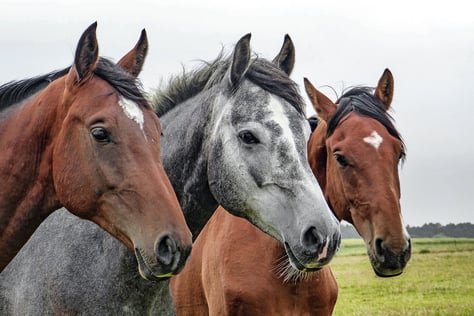 Now that winter is over (hopefully), you swore that you are not riding in a muddy arena next year. Whether you want an indoor or an outdoor arena, it's the footing that will make or break how good your arena is for you and your horse. Good footing is important in reducing the risk of lameness as well as optimizing performance. Constant wear and tear of the joints from bad footing is a leading cause of soft tissue injuries of muscles, ligaments, and tendons. In addition, a horse that does not feel secure and safe on footing will not feel comfortable jumping or otherwise performing to the best of his ability. Below are five things you should consider for the best arena footing for your horse.
Now that winter is over (hopefully), you swore that you are not riding in a muddy arena next year. Whether you want an indoor or an outdoor arena, it's the footing that will make or break how good your arena is for you and your horse. Good footing is important in reducing the risk of lameness as well as optimizing performance. Constant wear and tear of the joints from bad footing is a leading cause of soft tissue injuries of muscles, ligaments, and tendons. In addition, a horse that does not feel secure and safe on footing will not feel comfortable jumping or otherwise performing to the best of his ability. Below are five things you should consider for the best arena footing for your horse.
1. Design for Your Arena Based on Usage
Different types of horse sports may require different sizes and types of arena. Are you doing some training of young horses? A round pen may be a necessity. If you’re a dressage rider, your arena would be a minimum of 20m x 60m. If you are jumping or holding driving competitions, your arena will be considerably larger. If your facility will be holding horse shows, you may want to consider extra room for warm-ups or to meet the requirements of your show’s sanctioning organization.
Will your arena be indoor or outdoor? If outdoor, will it be used in all types of weather or just in the summer? Will you be using it for lessons where students ride on the rail for much of the lesson, or vaulting where the horse will be working on a consistent circle? These answers will not only help you design your arena, but will help you determine the best footing for its use.
2. Location, Location, Location
Before you begin any work on your arena, objectively look at your proposed site. Is it level enough for riding, but with enough slope for water to run off? Are there any drainage issues, especially during our typical rainy season? If you anticipate having to water your arena during the summer, is it located near a water source?
Another important factor is to know what type of soil you have. Different types of soils may determine the type and depth of base you will need as well as the type of footing. Dig a 4 foot deep hole in your proposed site to get the best idea of what sort of soil you have. While your soil may appear to be sandy on top, it may actually be heavy clay only a few inches down and that will affect your drainage no matter what type of footing you use.
Finally, when roughing out your arena, consider making the site a little bigger than the actual dimensions of the finished arena, especially if you are using fencing or wish to allow room for horses to warm up around the arena. For example, for a 20m x 40m dressage arena, the “pad” should be approximately 30m x 50m.
3. Start with a Good Foundation
An often overlooked, but extremely important aspect of good footing is the part you rarely see – the foundation. This is not the place to cut corners on either time of materials. According to the U.S. Dressage Federations arena and footing guide, “Under Foot,” your arena foundation ideally should consist of a sub-base (most often the existing soil of the site) and a base (usually made of crushed and compacted stone to produce a solid, non-shifting and non-slippery surface). The depth of the base is usually determined on how the arena will be used – remember your design plan? A dressage arena may not have as deep a base as one used for jumping or for heavy use.
The use of geotextiles, a type of synthetic material available in different thicknesses, is an excellent addition when building your arena. It goes between the sub-base and the base and improves drainage, prevents soil or rocks from your sub-base from moving up and mixing with your base, and generally protects the sub-base during construction of the base.
Footing is only as good as its base. While you can create an arena with just a base and the riding surface or even with just adding footing alone if finances are an issue, you may end up saving money on the arena only to pay vet bills later. What’s on top is not nearly as important as what is underneath your riding surface.
4. Find Your Footing
When selecting the footing surface for the top level of the arena, go back to your arena design and consider how the arena will be used, whether indoor or outdoor or heavy use vs. private barn. Do you need the traction and cushioning for jumpers or the firm support for dressage horses?
To keep cost down, consider what’s accessible in your area. Both sand and hog fuel are possibilities. There are also footing options made from rubber. Crumb rubber is made from recycled tires, but products made from other sources of rubber are also available. Rubber products are typically mixed with sand. All options have pros and cons depending on your discipline, ease of maintenance, whether for indoor or outdoor use, and cost. To help eliminate respiratory problems of both horse and rider, good footing should not be dusty or have an odor. If possible, “test drive” different types of footing - what feels best to you and your horse when you ride on it?
Always be sure to purchase your arena footing from a knowledgeable and reputable company. It is best to purchase less footing material than you think you’ll need. It’s easy enough to add more product, but almost impossible to take out footing if it’s too deep.
5. Maintenance
Now that you’re beautiful arena is complete, it’s important to regularly maintain it so it will last for years to come. Depending on your type of footing and where you live, routine watering, dragging or harrowing, or applying dust-reducing agents may all be part of your arena’s regular upkeep. It’s better to head off potential problems by looking for and repairing ruts, holes or uneven areas and slippery spots than to wait until the damage has been done.
Remember to also maintain the area directly outside the arena. Footing can be pushed outside and this can block drainage. If you created drainage ditches to help with water runoff, be sure they are kept free of weeds or debris.
If you are still confused about how to build your arena or what sort of footing to use, there are a number of arena consulting firms in our area who specialize in designing arenas or making footing recommendations specifically for your discipline or the area where you ride.
Resources:
“Underfoot, the USDF Guide to Dressage Arena Construction, Maintenance and Repair” by the United States Dressage Federation
“The Equine Arena Handbook” by Robert Malmgren
“Horse Stable and Riding Arena Design” by Eileen Fabian Wheeler
<span style="color:#000000;"><em>Photo credit: Classic Equine Equipment</em></span>



